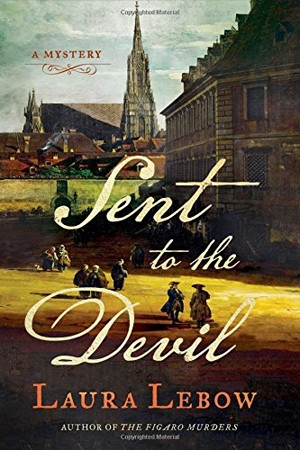
A history buff and opera fan, Laura Lebow’s lively recreation of Mozart’s Vienna is a delightful mix of fact and fiction. The gore is kept firmly off the page, and the atmosphere of the city during its cultural heyday under Joseph II reigns uppermost, despite the ominous distant rumblings of war against the Turks.
The mystery is about a serial killer who is targeting senior figures of authority in the military, the church, aristocracy and so on. Although the series is sometimes labelled as ‘the Mozart mysteries’, the amateur detective is in fact Lorenzo Da Ponte, Mozart’s real life librettist for such masterpieces as The Wedding of Figaro, Cosi Fan Tutte and a reworking of Don Giovanni (which the author amusingly refers to in the novel). Da Ponte is a lesser-known figure nowadays, which allows for considerable artistic licence, but at the time he was quite a colourful figure himself. Not only did he collaborate with Salieri and many other composers, he was also a poet and translator and had an extremely interesting life. Born Jewish, he became a Roman Catholic priest, but was eventually banished from his home town in Venice for his dissolute lifestyle. All of this is hinted at in the book, and it comes as no surprise that he counts Giacomo Casanova amongst his friends. However, Lebow shows him to be a lonely and thoughtful hero, bearing witness to the tense political atmosphere and torn loyalties of the time.
One of Vienna’s leading military commanders is viciously murdered in a central town square. It appears someone lured him there by night under false pretences. When Da Ponte’s old friend and mentor, Alois, is found murdered in similar fashion, the librettist reluctantly becomes involved in the mystery, although he hates working with the Emperor’s secret police. Who could possibly have hated the mild-mannered former priest turned avid book collector? And why has someone carved strange symbols on his forehead? Soon, it becomes clear that a serial killer is on the loose, a killer who selects each victim as a representative of one of the seven deadly sins. Da Ponte has to tiptoe between the church and the police, between the egos of the opera world and the aristocracy, to unmask the killer before he himself becomes the next victim.
Casanova, Mozart, Mozart’s wife and Salieri all make cameo appearances in the story, and remain pleasingly plausible figures, without overwhelming the story. The plotting sometimes gets lost in the atmospheric recreation of the city, and the motive for the murders seems a tad over the top too. However, the author has done her research meticulously and it is true that the reforms the idealistic Emperor Joseph II tried to implement really angered traditionalists at the time, particularly the clergy and aristocracy, with his attempts to allow the common people into the charmed inner circles of culture and power. Meanwhile his skirmishes with the Turks proved a drain on the very same common people, so a backlash was soon to follow and his modernising policies eventually failed.
This makes it sound like you have to be an expert in 18th century European history to enjoy this novel, which is not at all the case. There are plenty of amusing and even romantic moments in the book, and it manages to steer clear of too many information dumps.
Sent to the Devil is an entertaining read to while away a dreary afternoon. It will also inform you and make you eager to find out more about those times and the beautiful city of Vienna. This is the second in the series featuring Da Ponte, after The Figaro Murders, but you don’t need to have read the first to enjoy this one.
Minotaur Books
Print/Kindle/iBook
£18.64
CFL Rating: 4 Stars








